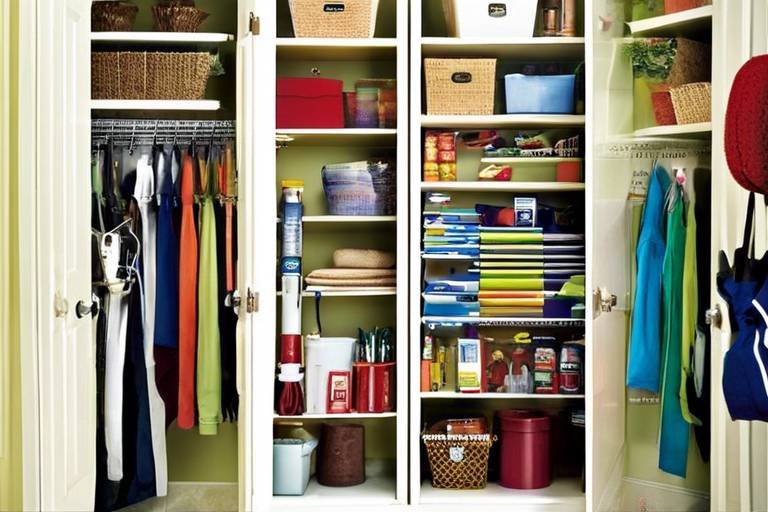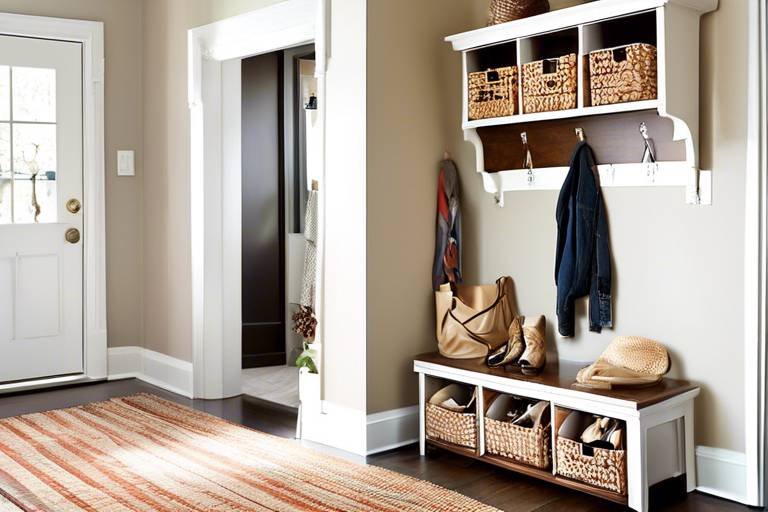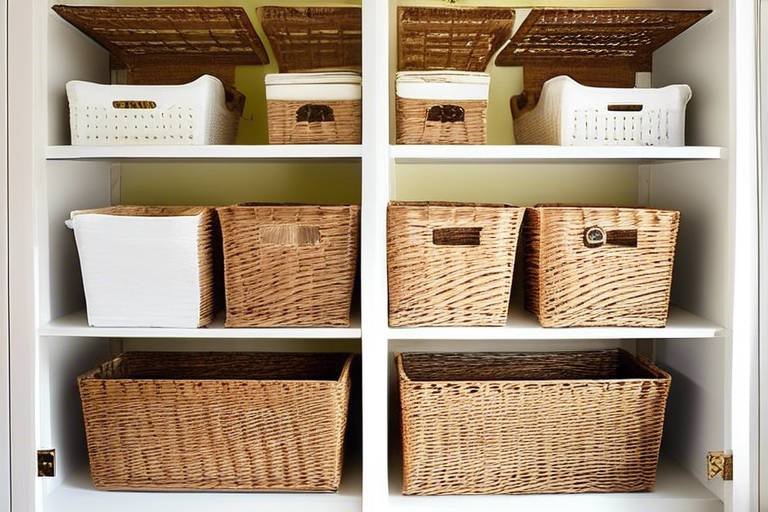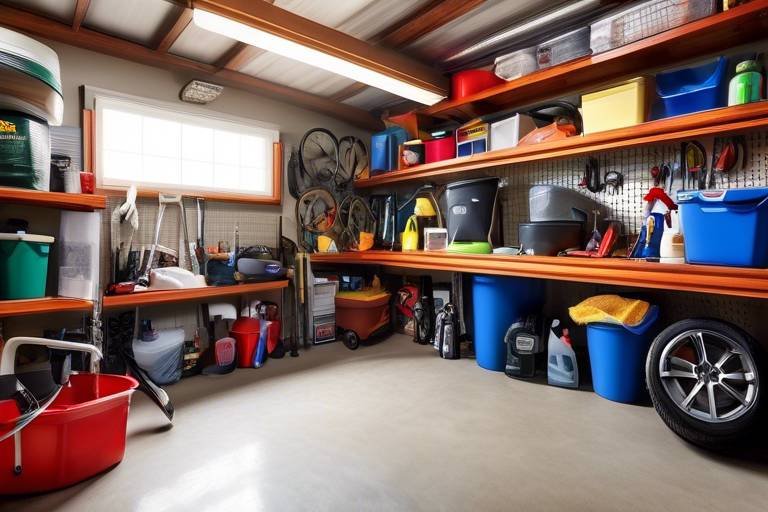Tips for Organizing Your Home’s Utility Closet
Organizing your home's utility closet is essential for maintaining a functional and clutter-free space. By following these practical tips, you can efficiently manage your utility closet, maximize space, improve accessibility, and store essential household items in an organized manner.
First and foremost, start by assessing the contents of your utility closet. Discard any expired products, duplicates, or items that you no longer use. Creating a clean and organized space will set the foundation for an efficient organization system.
Utilizing vertical space is key to maximizing storage in your utility closet. Install shelves, hooks, and racks to take advantage of the height of the closet. This will not only create more storage space but also make it easier to access frequently used items.
Categorizing items is another crucial step in organizing your utility closet. Sort items into categories such as cleaning supplies, tools, and household essentials. Use labeled bins or containers to keep similar items together and easily identifiable.
Creating zones within your utility closet can help maintain order and efficiency. Designate specific areas for different categories of items, such as a cleaning zone, tool zone, and storage zone. This will make it easier to locate items when needed.
Implementing storage solutions like clear bins, drawer organizers, and stackable containers can help maximize space and keep small items organized. These solutions not only create a neater appearance but also make it easier to find and access items quickly.
Regular maintenance is key to ensuring that your utility closet remains functional and clutter-free over time. Establish a routine for decluttering, cleaning, and organizing the space to prevent it from becoming disorganized again.
Labeling everything in your utility closet is a simple yet effective way to maintain organization. Label shelves, bins, and containers to easily identify the contents of each storage area. This will make it effortless to find what you need and keep everything in its designated place.
Optimizing lighting in your utility closet is essential for improving visibility. Consider adding LED lights or a battery-operated light to brighten up the space, especially in dimly lit areas. Proper lighting will make it easier to locate items and navigate the closet efficiently.
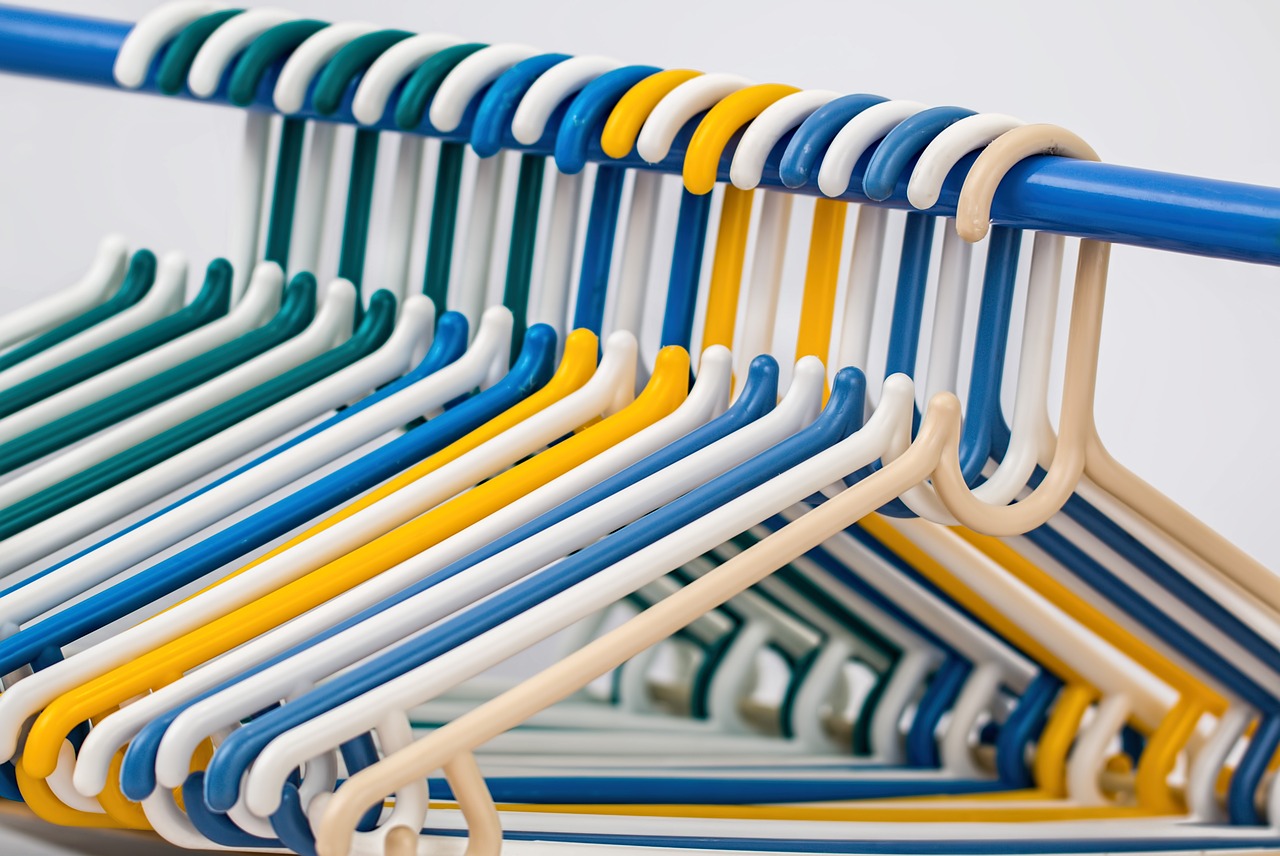
Assess and Declutter
Efficiently manage your utility closet with these practical tips to maximize space, improve accessibility, and maintain a clutter-free environment while storing essential household items.
Begin by evaluating the items in your utility closet, discarding expired products, duplicates, and unused items to create a clean and organized space. Consider creating a table to list items that need to be discarded and those that can be kept. This initial step sets the foundation for an organized utility closet, ensuring that you only keep what is necessary and functional.
Assessing and decluttering your utility closet is like cleaning out a cluttered room - it's essential to identify what serves a purpose and what is simply taking up space. By taking the time to declutter, you can create a more efficient storage space that allows for better organization and easier access to the items you need.
Imagine your utility closet as a treasure chest filled with valuable items, but also some forgotten treasures that are no longer useful. Decluttering is like sifting through this chest to uncover the gems while discarding the unnecessary clutter that hinders your ability to find what you need when you need it.
Once you have assessed and decluttered your utility closet, you will notice a significant difference in the accessibility and functionality of the space. It's like clearing a path through a dense forest - suddenly, navigating through the trees becomes easier, and you can see the beauty of the forest without the obstruction of unnecessary clutter.
Remember, the key to an organized utility closet is to regularly assess and declutter to maintain a streamlined and efficient storage space. By making this a routine part of your home maintenance, you can ensure that your utility closet remains clutter-free and functional for the long term.
Q: How often should I assess and declutter my utility closet?
A: It is recommended to assess and declutter your utility closet at least twice a year to ensure that it remains organized and clutter-free.
Q: What should I do with items that are still in good condition but no longer needed?
A: Consider donating or giving away items that are still functional but no longer serve a purpose in your home. This allows you to declutter while giving someone else the opportunity to benefit from these items.
Q: Can I involve my family members in the decluttering process?
A: Yes, involving your family members in the decluttering process can make it a collaborative effort and help instill good organizational habits in everyone. Assigning specific tasks and responsibilities can make the process more efficient and enjoyable for all involved.

Utilize Vertical Space
Efficiently manage your utility closet with these practical tips to maximize space, improve accessibility, and maintain a clutter-free environment while storing essential household items.
When it comes to organizing your home's utility closet, one of the most effective strategies is to . By installing shelves, hooks, and racks on the walls, you can make use of the often underutilized vertical area in the closet. This not only maximizes storage space but also allows for better organization and easier access to frequently used items.
Imagine the walls of your utility closet as blank canvases waiting to be transformed into efficient storage solutions. With the right shelving units and hooks in place, you can hang cleaning supplies, tools, and other items vertically, freeing up valuable floor space and keeping everything within reach.
By creating a vertical storage system, you can categorize items based on their use and frequency, making it easier to locate what you need without rummaging through cluttered shelves. This approach not only saves space but also adds a visual appeal to your utility closet, turning it into a well-organized and functional area of your home.
Additionally, consider using stackable containers or bins that can be easily mounted on the walls to store smaller items like nails, screws, or batteries. This way, you can keep these items neatly organized and visible, preventing them from getting lost in the depths of your closet.
Overall, by thinking vertically and implementing smart storage solutions, you can transform your utility closet into a streamlined and efficient space that not only looks visually appealing but also makes your daily tasks easier and more enjoyable.
Stay tuned for some common questions and answers about organizing your home's utility closet:
- Q: How often should I declutter my utility closet?
- A: It's recommended to declutter and organize your utility closet at least once every 3-6 months to ensure it remains functional and clutter-free.
- Q: What are the essential items to keep in a utility closet?
- A: Essential items for a utility closet include cleaning supplies, tools, light bulbs, batteries, extension cords, and other household necessities.
- Q: How can I maintain the organization of my utility closet in the long run?
- A: Regular maintenance, labeling items, and having a designated place for each category of items are key to maintaining an organized utility closet over time.

Categorize Items
When it comes to organizing your home's utility closet, categorizing items is a crucial step in maintaining order and efficiency. By sorting items into specific categories, such as cleaning supplies, tools, and household essentials, you can create a structured system that makes it easier to locate items when needed. Using labeled bins or containers to keep similar items together not only helps in organization but also ensures that everything is easily identifiable at a glance.
Imagine your utility closet as a well-organized library, with each category representing a different genre of books neatly arranged on shelves. Just like finding your favorite novel in a library is made easier by categorizing books by genre, categorizing items in your utility closet simplifies the process of finding what you need quickly. This approach not only saves time but also eliminates the frustration of rummaging through cluttered spaces.
Creating a visual representation of the categories within your utility closet can further enhance organization. Consider using color-coded labels or tags to differentiate between cleaning supplies, tools, and other essentials. This visual cue can serve as a quick reference guide, allowing you to locate items effortlessly without the need to search through every shelf or container.
Additionally, implementing a subcategorization system within each main category can streamline the organization process even further. For instance, within the cleaning supplies category, you can further divide items into subcategories such as surface cleaners, laundry detergents, and disinfectants. This level of detail ensures that items are not only grouped by similarity but also by specific use, making it easier to retrieve the exact item you need.
Think of categorizing items in your utility closet as creating a roadmap that guides you to your destination without any detours. Just as a well-marked trail leads hikers through a forest with clear signposts, categorizing items provides a clear path to the item you are searching for, eliminating the need to navigate through a maze of clutter.

Create Zones
Efficiently manage your utility closet with these practical tips to maximize space, improve accessibility, and maintain a clutter-free environment while storing essential household items.
Begin by evaluating the items in your utility closet, discarding expired products, duplicates, and unused items to create a clean and organized space.
Install shelves, hooks, and racks to make use of vertical space, allowing for better organization and easier access to frequently used items in your utility closet.
Sort items into categories such as cleaning supplies, tools, and household essentials, using labeled bins or containers to keep similar items together and easily identifiable.
When organizing your utility closet, creating zones can significantly improve efficiency. Designate specific areas for different categories of items, such as a cleaning zone, tool zone, and storage zone. By separating items into zones, you can easily locate what you need without rummaging through everything. Think of it as creating neighborhoods within your closet, each with its own purpose and order.
Utilize storage solutions such as clear bins, drawer organizers, and stackable containers to maximize space and keep small items organized and easily accessible in your utility closet.
Establish a routine for decluttering, cleaning, and organizing your utility closet to ensure that it remains functional and clutter-free over time.
Label shelves, bins, and containers to easily identify the contents of your utility closet, making it simple to find what you need quickly and maintain organization.
Ensure proper lighting in your utility closet by adding LED lights or a battery-operated light to improve visibility and make it easier to locate items, especially in dimly lit areas.

Implement Storage Solutions
When it comes to organizing your home's utility closet, implementing effective storage solutions is key to maximizing space and keeping essential items easily accessible. By utilizing storage solutions such as clear bins, drawer organizers, and stackable containers, you can create a well-organized and clutter-free environment in your utility closet.
Clear bins are a great option for storing small items such as screws, nails, or batteries, allowing you to see the contents at a glance and easily find what you need. Drawer organizers can help keep tools or cleaning supplies neatly arranged, preventing them from getting jumbled together and making it difficult to locate specific items.
Stackable containers are ideal for maximizing vertical space in your utility closet, allowing you to store items efficiently without taking up unnecessary space. By stacking containers of varying sizes, you can make the most of the available space and keep items organized based on their use or category.
Additionally, consider using labels on your storage solutions to clearly identify the contents of each bin or container. This simple step can save you time and effort when searching for specific items, as well as help maintain the organization of your utility closet over time.

Maintain Regular Maintenance
Regular maintenance is essential to keep your utility closet organized and functional. By establishing a routine for decluttering, cleaning, and organizing, you can ensure that your space remains clutter-free over time. Regular maintenance involves inspecting the contents of your utility closet, identifying any items that need to be discarded or replaced, and reorganizing as necessary to maintain efficiency.
One effective way to maintain regular maintenance is to schedule specific times for decluttering and organizing your utility closet. Whether it's a weekly task or a monthly project, setting aside dedicated time to assess the contents of your closet can prevent clutter from building up and ensure that everything is in its proper place.
During regular maintenance sessions, take the opportunity to dust shelves, wipe down containers, and vacuum the floor of your utility closet. Keeping the space clean not only enhances its appearance but also contributes to a more hygienic environment for storing household items.
Another aspect of regular maintenance is checking for expired products or items that are no longer needed. Dispose of any expired cleaning supplies, expired batteries, or broken tools to free up space and prevent clutter. By regularly purging unnecessary items, you can optimize the storage capacity of your utility closet.
Consider creating a maintenance checklist to guide your regular upkeep efforts. This checklist can include tasks such as checking for leaks, inspecting the condition of tools, and ensuring that all items are properly stored. By following a structured checklist, you can stay organized and address maintenance tasks systematically.
Additionally, involve other household members in the maintenance of the utility closet to distribute the workload and instill a sense of responsibility for keeping the space organized. By sharing the task of regular maintenance, you can ensure that everyone contributes to maintaining a clutter-free and efficient storage area.
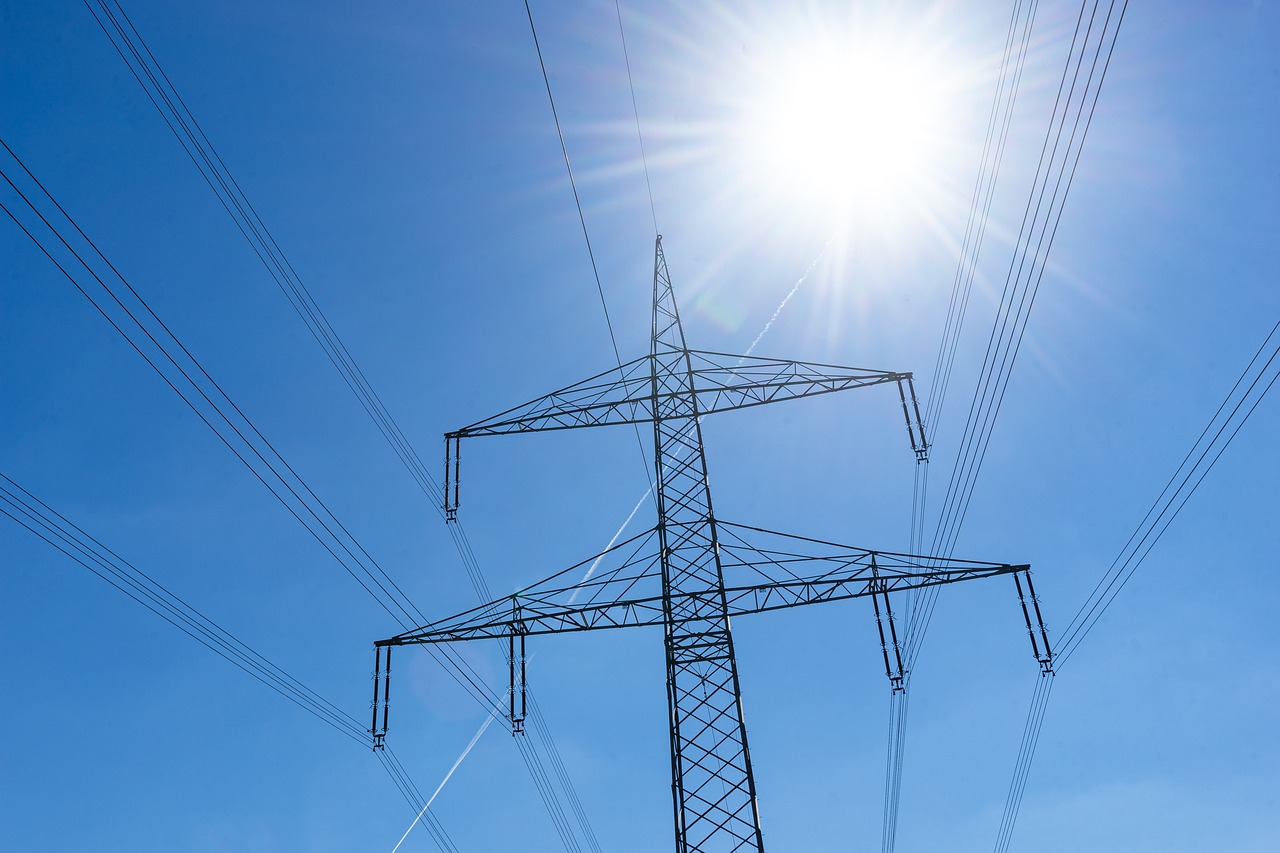
Label Everything
When it comes to organizing your home's utility closet, one crucial tip that can significantly enhance efficiency and accessibility is to . By clearly labeling shelves, bins, and containers, you can easily identify the contents of your utility closet, making it a breeze to locate items quickly and maintain a high level of organization.
Imagine walking into your utility closet and being able to immediately spot the exact cleaning supplies you need without rummaging through cluttered shelves. Labels act as your personal guide, leading you to the right spot effortlessly. They not only save you time but also prevent frustration and confusion, especially during urgent situations.
To take labeling to the next level, consider creating a labeling system that is both functional and visually appealing. Use a consistent font style and color for all labels to maintain uniformity. Additionally, you can color-code labels based on categories to further streamline the organization process.
If your utility closet consists of multiple shelves or sections, a table of contents can be a game-changer. Create a small table or chart that outlines the different zones or categories within your closet and their corresponding labels. This quick reference guide can help you navigate the space with ease.
Moreover, don't underestimate the power of descriptive labels. Instead of simply writing "cleaning supplies," consider specifying the contents further, such as "glass cleaner," "all-purpose spray," or "dusting cloths." Detailed labels leave no room for ambiguity and ensure that every item has its designated place.
By embracing the practice of labeling everything in your utility closet, you not only maintain order and organization but also transform a once chaotic space into a well-structured and efficient storage area. So, grab your label maker and start adding clarity and convenience to your home's utility closet today!

Optimize Lighting
When it comes to organizing your home's utility closet, lighting plays a crucial role in enhancing visibility and ease of access. By optimizing the lighting in your utility closet, you can significantly improve the functionality of the space and make it more convenient to locate items, especially in dimly lit areas.
One effective way to optimize lighting is by incorporating LED lights into your utility closet. LED lights are energy-efficient, long-lasting, and provide bright illumination, making it easier to see and retrieve items stored in the closet. You can install LED light strips or fixtures on the ceiling or walls to ensure even distribution of light throughout the space.
Another option to consider is adding a battery-operated light to your utility closet. These lights are easy to install and operate, offering a convenient solution for illuminating specific areas within the closet. Battery-operated lights are particularly useful for lighting up dark corners or shelves where visibility is limited.
By optimizing the lighting in your utility closet, you can create a well-lit and organized space that facilitates efficient storage and retrieval of essential household items. Whether you're searching for cleaning supplies, tools, or other necessities, proper lighting can make a significant difference in enhancing the overall functionality of your utility closet.
Frequently Asked Questions
- How often should I declutter my utility closet?
It is recommended to declutter your utility closet at least once every 3 to 6 months to ensure that it remains organized and free of unnecessary items.
- What are some common categories to consider when organizing a utility closet?
Common categories for organizing a utility closet include cleaning supplies, tools, gardening equipment, household essentials, and automotive products.
- How can I make the most of limited space in my utility closet?
To maximize space in a small utility closet, consider using vertical storage solutions such as shelves, hooks, and stackable containers, and make use of door space for hanging items.
- Why is labeling important in organizing a utility closet?
Labeling shelves, bins, and containers in your utility closet helps you quickly locate items, maintain organization, and ensure that everything has a designated place for easy access.
- What is the best way to prevent clutter from building up in a utility closet?
To prevent clutter, establish a regular maintenance routine, avoid storing items that are no longer needed, and designate specific zones for different categories of items to maintain order.

